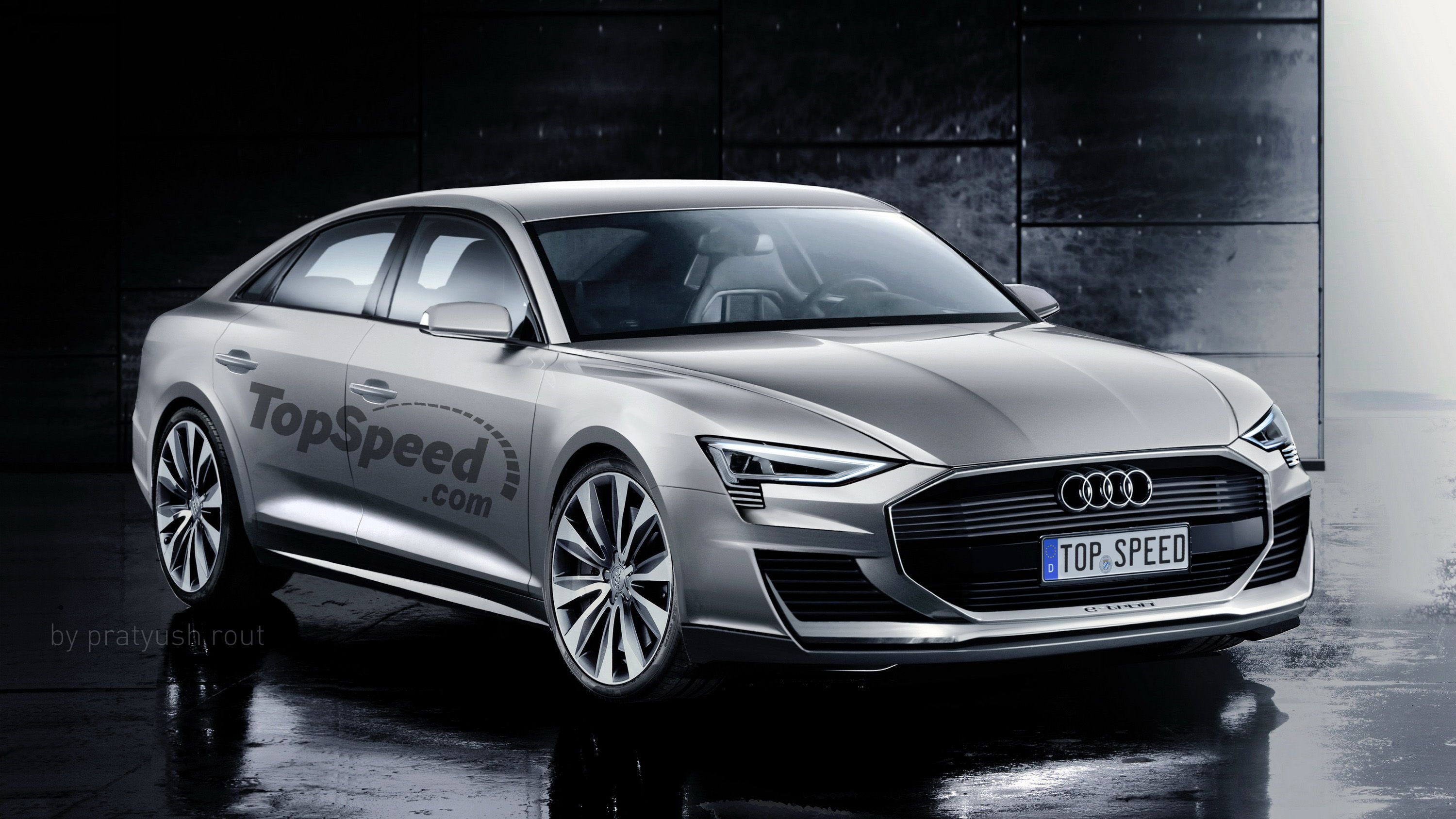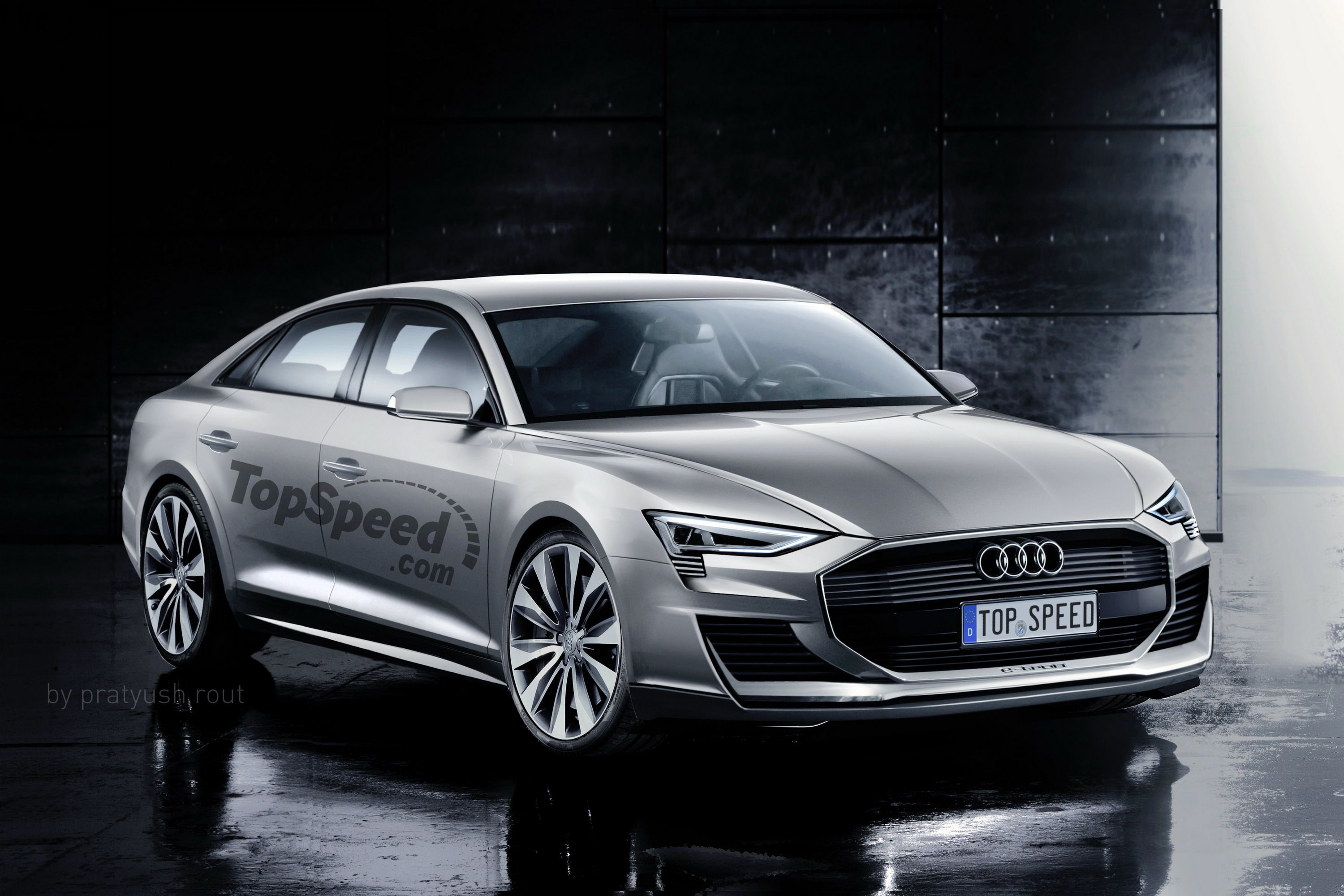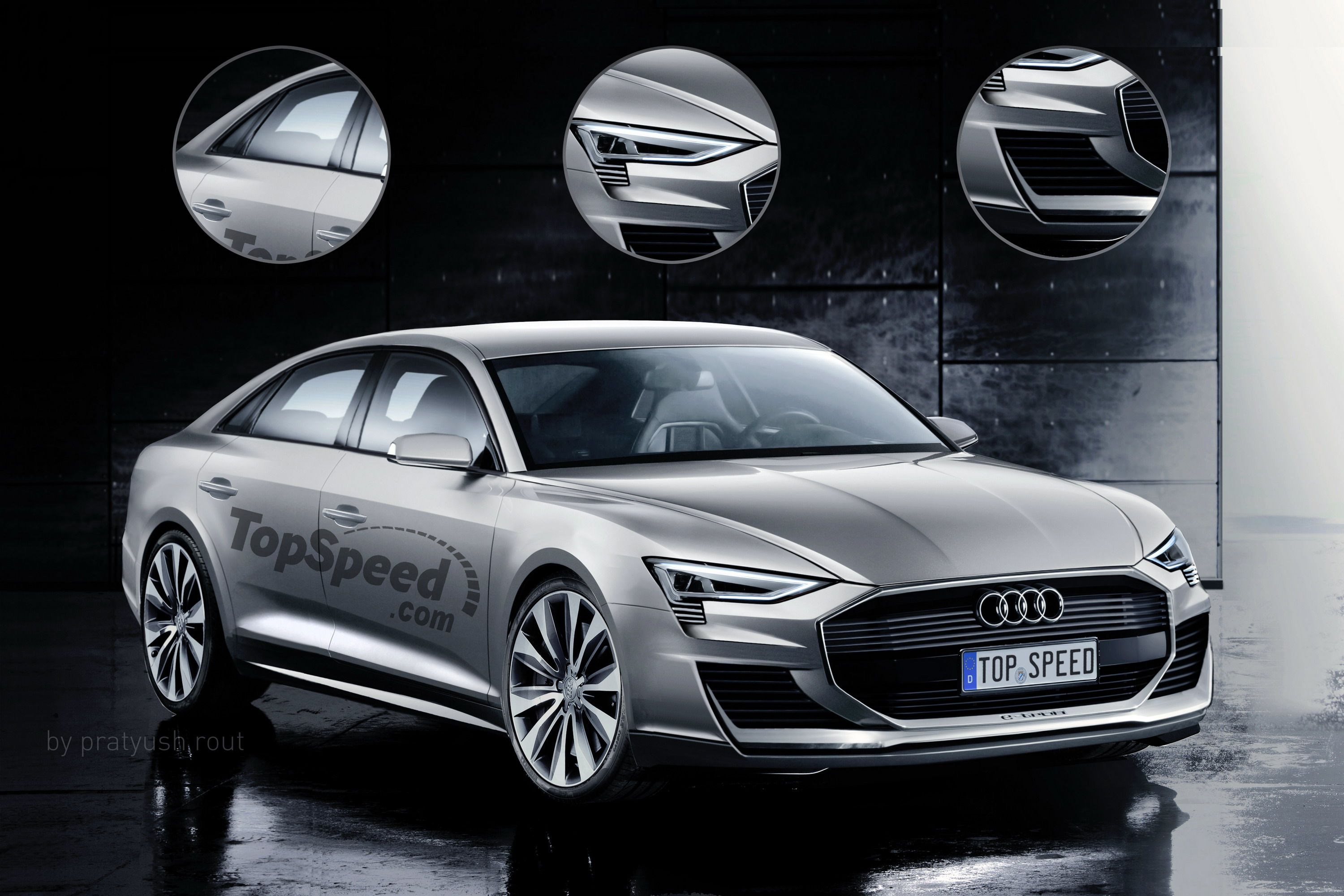Rumors that Audi is planning to launch an A9 model have been flying around for quite a few years now. Come 2016 and the German brand has confirmed that a brand-new model to use this nameplate is indeed underway and will hit the market by 2020. However, while the plans were to create the A9 as a larger, coupe-styled four-door, Audi decided to go with an electric sedan that would compete against the popular Tesla Model S.
Set to be introduced "as high up as possible in the A8 segment," the upcoming A9 was previewed by the E-tron Quattro concept at the 2015 Frankfurt Motor Show. It is believed that the exterior design will be similar, while motivation will be provided by an evolution of the concept car's drivetrain. The A9 E-tron will also share technology with the upcoming Q6 E-tron SUV.
Both vehicles are part of Audi's recent strategy to increase the number of electric vehicles in its lineup. The company wants to have three EVs by 2020, which it will achieve with the A3, A9, and Q6 E-trons, and extend it to 25 percent of its lineup by 2025. Most details as to what the new A9 E-tron will bring to the market are not yet available, but we have the E-Tron Quattro concept to look at for certain hints. Check out our speculative review and rendering for more information and stay tuned for updates.
Continue reading to learn more about the Audi A9 E-tron.
2020 Audi A9 E-tron
- Make: Array
- Model: 2020 Audi A9 E-tron
- [do not use] Vehicle Model: Array
Exterior
The A9 E-tron is expected to have similar proportions to the next-generation A8, but Audi could choose to make it a tad longer in order to justify its range-topping status from a dimensional standpoint too. As far as styling goes, it will most likely share a number of body panels with the A8, especially the doors and fenders, but the fascias and roofline will be unique to this model.
Exterior Comparison: A9 E-tron vs E-tron Quattro concept
The roof will be the main feature that will set it apart from the A8, as the A9 will sport a more coupe-like rear section with a raked rear glass and C-pillars. I also think that the front fascia will be heavily based on the E-tron Quattro concept. The production model should sport a similar, wide grille with thick horizontal slats and aggressive looking headlamps with LED technology. The small horizontal LED strips seen below the headlamps on the concept car could also make it on the production model. The bumper, on the other hand, should carry a sportier design with larger side intakes and an aerodynamically optimized splitter. Of course, all these concept-inspired elements will be revised to suit a sedan instead of an SUV. As a result, the grille will be flatter and the bumper will sit closer to the ground.
Around back, I expect the A9 E-tron to borrow heavily from the production A8. The layout should be clean and simple, and include a pair of slender taillights, a trunklid spoiler, and a rather mild looking bumper devoid of the wide exhaust pipes usually found on the gasoline or diesel A8.
Overall, the A9 E-tron should have a sleek yet elegant appearance that will stand out against the competition.
Competing designs
Speaking of the competition, the A9 E-tron will hit the streets as a premium proposition for the highly popular Tesla Model S. The American sedan is also quite sporty by design, but unlike the Audi, employs more organic cues. Both the front grille and headlamps feature rounded edges, while the wavy belt line gives it a Coke bottle-like styling. The wide rear haunches, the prominent trunklid spoiler, and the big, chrome strip connecting the taillights round off the Model S' exterior. On the other hand, the Tesla could use a facelift now that the design is some four years old as of 2016.

|
While it's definitely a fresh proposition to the Model S, the A9 E-tron will probably seem dull and uninspired when Porsche launches the production version of the Mission E. Granted, the two cars won't compete in the exact same niche in terms of performance figures and pricing, but the similar size and electric drivetrain will inevitably spawn comparisons. We still don't know how the production Mission E will look in the end, but it will borrow some from the 911. And let's face it, a 911-inspired sedan will be hotter than a sportier-looking A8 with a coupe roof.
Interior
The interior is a far bigger mystery than the exterior, but Audi could use the E-tron Quattro as inspiration in this department too, especially since the concept is far from wild. The dashboard layout is pretty simple and Audi kept things clean on the passenger side. The center stack section is occupied by a massive touchscreen, while the console includes a smaller display and drivetrain controls. A third screen, this time almost as large as the one on the center stack, is located behind the steering wheel, serving as an instrument cluster, while also displaying various bits of information, including navigation-related content.
Note: Audi E-Tron Quattro Concept interior pictured here.
The steering wheel is of the sporty variety, featuring a three-spoke design with a flat bottom. All told, this layout would definitely work in a production model, but with a more conventional steering wheel, revised displays, and maybe Audi's recently introduced continuous air vent strip on the passenger side. Bolstered seats should be standard, but Audi will likely offer a sportier option. In the back, legroom should be comparable to the A8, but shoulder and headroom will probably fall behind due to the coupe roofline. Fortunately, the battery's placement in the floor won't affect cabin room.
As with any upscale Audi, the A9 E-tron's interior will be packed with the finest materials, especially in its more expensive trims. Look for leather and Alcantara upholstery, glossy trim, and aluminum inserts. Optionally, customers will be able to order carbon-fiber trim.
Will this be enough against the Model S?
It should, because even though the Model S is on the premium side, it lacks many of the luxury features you can get with the current-generation A8. Still, the Tesla is well equipped and the massive 17-inch display screen will hold its own against anything the A9 E-tron may have to offer. The Model S' cabin also comes with a clean and simple layout, two-tone upholstery, sporty seats, and cup holders on the center console. The optional Premium Upgrades package adds Nappa leather for the armrests and dashboard, an Alcantara headliner, and LED ambient lighting. I'm sure that Audi will match that as standard on pricier trims, but it remains to be seen how expensive it will get.
Drivetrain
This is where a lot more information is available. First up, it's pretty clear that Audi will use a development of the EV platform showcased in the E-tron Quattro concept. The underpinnings are made mostly of aluminum and include three electric motors. One is placed at the front and motivates the front wheels, while the two in the back spin the rear wheels. The system sends power to all four wheels via a drive management system, which uses electronic torque vectoring to split the torque depending on grip levels. An updated version of the single-ratio gearbox should offer two modes: Drive and Sport.
Note: Audi E-Tron Quattro Concept drivetrain pictured here.
The E-tron Quattro concept had 429 horsepower standard, while the Sport mode enabled the drivetrain to temporarily generate 496 horses and 590 pound-feet. It's safe to assume that the production model will boast similar ratings, but Audi may also opt to offer different outputs. This means we could also get an A9 E-tron with less than 400 horsepower and a version with around 600 horses. These would enable the A9 to become a full-fledged competitor for the Model S, which is available with outputs from 382 to 762 horsepower.
Performance-wise, we do know that the concept needs 4.6 seconds to hit 60 mph. Expect this figure to vary between 5.5 and 3.8 seconds depending on the horsepower and torque of each model. The E-tron Quattro's top speed is limited to 131 mph, but it could increase to 155 mph for the production model. Audi also promises a range of up to 500 km, which converts to around 311 miles. This figure will enable the A9 E-tron to give the Model S a run for its money, but it will be interesting to see whether the German brand will come up with a more powerful battery by 2020.
Speaking of the battery, Audi is expected to use a liquid-cooled 95-kWh unit. Options will include an inductive charging port using Audi's latest wireless technology, together with an autonomous parking function that will automatically park the car over a charging plate.
Audi also plans to offer the A9 with autonomous drive. According to Ricky Hudi, head of electric development at Audi, the A9 will become the first car to use Level 4 autononous technology. In 2017, the new A8 will debut with Level 3 automation, but Audi plans to improve the system by the time the A9 E-tron hits the market. “Level four is challenging because it requires considerable improvements to sensors and processing power. But it represents a big leap, because the car will be able to drive itself in many situations — not only on the motorway," he told Autocar.
Hudi also revealed that Audi wants to use asynchronous electric motor instead of the already available synchronous units. The technology will debut in 2018 and find its way into the A9 E-tron. “Some rivals have gone for a synchronous motor with a high power density but at relatively low revs. There are also asynchronous motors that typically achieve similar power outputs but at much higher revs. From 2018, our electric cars will be equipped with asynchronous motors. We are convinced they offer higher efficiency levels than synchronous motors," he added.
Competing performance
When it comes to mainstream electric cars, the Tesla Model S has no rival as of 2016. This could change with the arrival of the A9 E-tron, but Audi needs to delivers some serious performance and mileage in order to stand a chance against Elon Musk's popular sedan. Since its introduction in 2012, the Model S has been offered in various specifications. These have changed over the years, but customers still have access to a wide choice of drivetrains. The base model comes with 382 horsepower, a range of 210 miles, a 0-to-60 mph sprint of 5.5 seconds, and a top speed of 130 mph. The same model with AWD has 518 horses, a range of 218 miles, and will hit 60 mph in 5.2 seconds. Moving over to the 75-kWh model, horsepower and acceleration remain the same, but top speed increases to 140 mph, while range goes up to 249 miles with RWD and 259 miles with AWD. Next up is the P90 AWD with 518 horsepower. With this model, you get a 294-mile range, a 0-to-60 sprint of 4.2 seconds, and a top speed of 155 mph. Finally, the recently introduced P100D is the most impressive Model S available, being able to run for 315 miles on a single charge and needing just 2.5 seconds to hit 60 mph.
Needless to say, Audi will have a hard time matching these numbers.
The upcoming production version of the Porsche Mission E concept will also be a tough nut to crack, especially with the German brand promising a 600-horsepower drivetrain and 0-to-60 mph times of 3.5 seconds. Driving range on the other hand will be similar to the A9 E-tron at 310 miles.
|
Tesla Model S 60 |
Tesla Model S 60 D |
Tesla Model S 75 |
Tesla Model S 75 D |
Tesla Model S 90D |
Tesla Model S P100D |
|
|
Battery |
60 KWh |
60 KWh |
75 KWh |
75 KWh |
90 KWh |
100 KWh |
|
Range |
210 miles |
218 miles |
249 miles |
259 miles |
294 miles |
315 miles |
|
0 to 60 mph |
5.5 seconds |
5.2 seconds |
5.5 seconds |
5.2 seconds |
4.2 seconds |
2.5 seconds |
|
Top Speed |
130 mph 130 mph |
140 mph |
140 mph |
155 mph |
155 mph |
155 mph |
Prices
It's way too early to talk about prices given that this car won't arrive until 2019 or so, but it's safe to assume that it will cost more than the A8 and will be one of the most expensive Audis on the market. Chances are it will fetch at least $120,000 before options and incentives.
Competing Prices
|
Tesla Model S 60 |
$55,500 |
|
Tesla Model S 60 D |
$60,500 |
|
Tesla Model S 75 |
$64,000 |
|
Tesla Model S 75 D |
$69,000 |
|
Tesla Model S 90D |
$79,000 |
|
Tesla Model S P100D |
$121,500 |
Competition
Tesla Model S
Launched in 2012, the Model S has set several new benchmarks in the industry and became the first mainstream EV to offer sports car-like performance and more than 200 miles of range in the same package. Available with various drivetrains that offer from 382 to 762 horsepower, the Model S can travel up to 315 miles in its most expensive version. What's more, thanks to the new P100D package, the Model S is the world's quickest sedan, needing on 2.5 seconds to hit 60 mph. That's as quick as the LaFerrari and faster than most high-profile sports cars on the market. Pricing starts from $53,000 for the base model, but it climbs into $120,000 territory for the range-topping P100D model.
Find out more about the Tesla Model S here.
Porsche Mission E
Porsche is also planning to launch a competitor for the Tesla Model S, but much like the A9 E-tron, it won't be here until 2020. The electric sedan will be based on the Mission E concept showcased in 2015 and Porsche has already confirmed that the drivetrain will be based on the electric system in its 919 Hybrid Le Mans race car. The Germans promise an output of 600 horsepower and a range of around 310 miles. The lithium-ion battery will get an option for a quick charge up to 80 percent capacity in a mere 15 minutes. The sedan should be able to hit 60 mph in around 3.5 seconds.
Learn more about the Porsche Mission E here.
Conclusion
The fact that more and more automakers are developing high-performance electric cars is by no means surprising. Tesla's enormous success with the Model S so far has prompted all major carmakers to revise their strategy in the EV segment and the A9 E-tron is one of the best example we can have. Initially outlined as a coupe version of the A8 with gasoline and diesel engines, the A9 was revised before being greenlighted and transformed into a premium EV. It's a strategy that should help Audi in the long run, but also benefit the entire Volkswagen Group following the "Dieselgate" fiasco.





